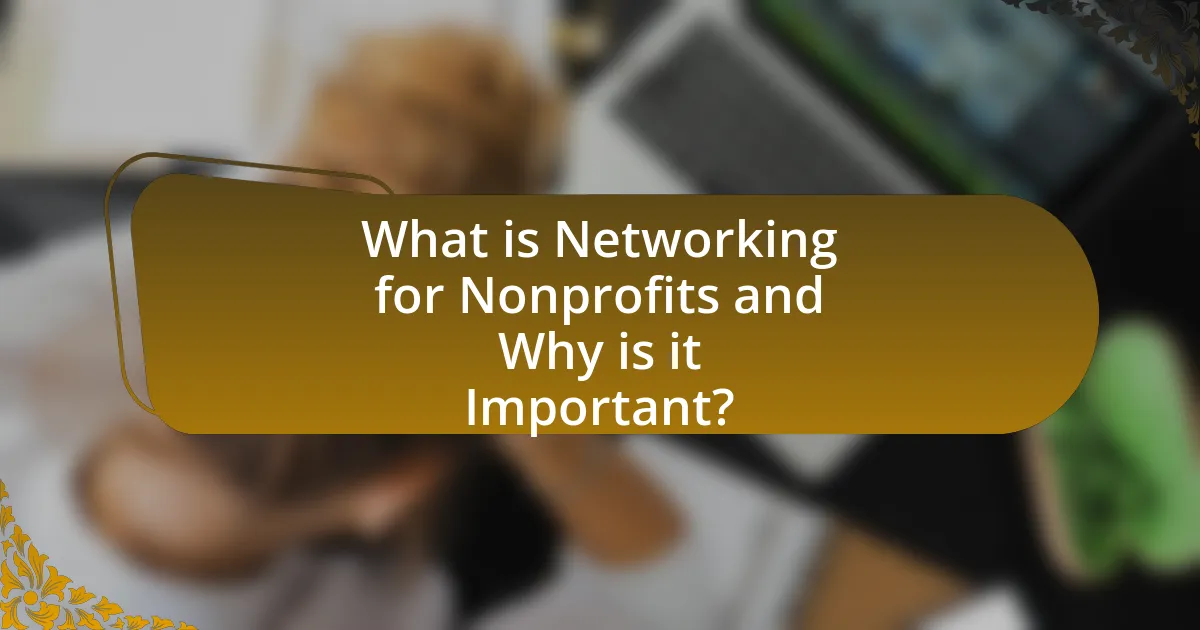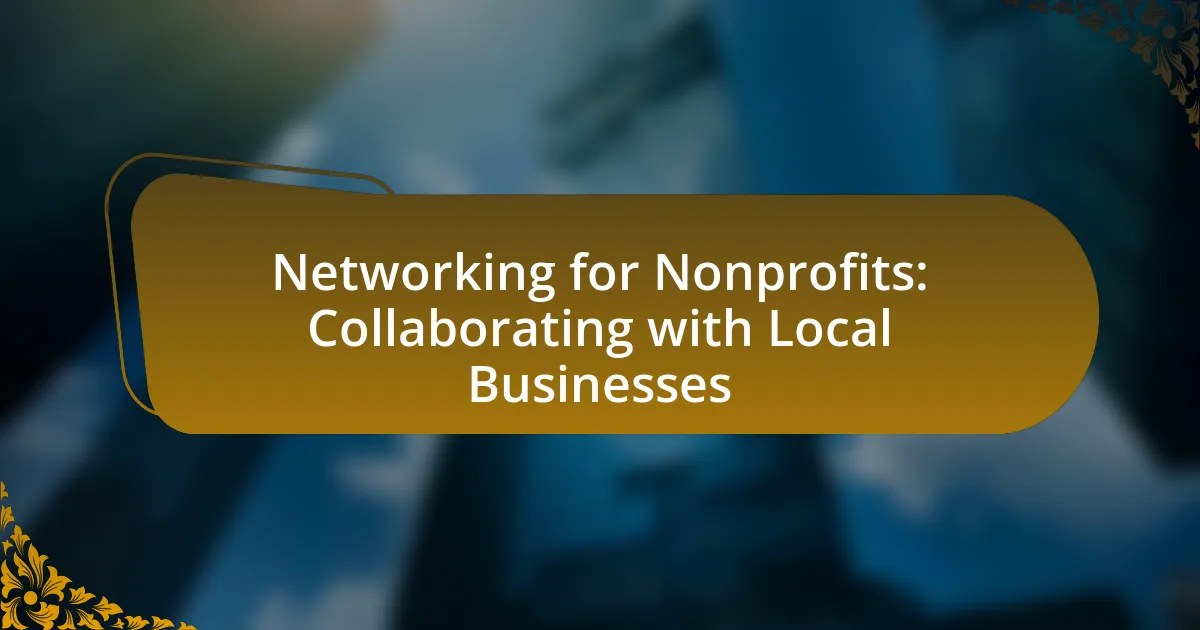Networking for nonprofits is the process of establishing relationships with individuals, organizations, and businesses to enhance collaboration and resource sharing, which is vital for accessing funding, expertise, and volunteers. The article explores the benefits of networking with local businesses, including increased visibility, credibility, and funding opportunities, as well as the challenges nonprofits face in these collaborations. It also discusses strategies for initiating partnerships, maintaining effective communication, and sustaining long-term relationships, while providing examples of successful nonprofit-business collaborations. Key practices for evaluating partnership effectiveness and adapting strategies based on outcomes are highlighted, offering practical tips for nonprofits to enhance their networking efforts.

What is Networking for Nonprofits and Why is it Important?
Networking for nonprofits involves building relationships with individuals, organizations, and businesses to enhance collaboration and resource sharing. This practice is crucial because it enables nonprofits to access funding, expertise, and volunteers, which are essential for achieving their missions. For instance, a study by the National Council of Nonprofits highlights that 75% of nonprofits report that networking leads to increased funding opportunities and community support. By fostering these connections, nonprofits can amplify their impact and sustainability in their communities.
How can nonprofits benefit from networking with local businesses?
Nonprofits can benefit from networking with local businesses by gaining access to resources, funding, and community support. This collaboration often leads to increased visibility and credibility for the nonprofit, as local businesses can provide sponsorships, donations, or in-kind services that enhance the nonprofit’s programs. For instance, a study by the National Council of Nonprofits indicates that partnerships with local businesses can lead to a 20% increase in funding opportunities for nonprofits. Additionally, networking fosters relationships that can result in volunteer support and shared expertise, further strengthening the nonprofit’s impact in the community.
What specific advantages do local partnerships provide to nonprofits?
Local partnerships provide nonprofits with enhanced resource access, increased visibility, and improved community engagement. By collaborating with local businesses, nonprofits can tap into shared resources such as funding, volunteers, and expertise, which can significantly bolster their operational capabilities. For instance, a study by the Stanford Social Innovation Review highlights that nonprofits engaged in local partnerships often experience a 30% increase in resource availability. Additionally, these partnerships elevate the nonprofit’s profile within the community, leading to greater public awareness and support for their mission. This visibility can translate into increased donations and volunteer participation, as local businesses often promote their nonprofit partners through their networks. Furthermore, local partnerships foster stronger community ties, enabling nonprofits to better understand and address the specific needs of the populations they serve, ultimately enhancing their impact.
How does networking enhance a nonprofit’s visibility in the community?
Networking enhances a nonprofit’s visibility in the community by fostering relationships with local businesses and stakeholders, which can lead to increased awareness and support for the nonprofit’s mission. When nonprofits engage in networking, they create opportunities for collaboration, share resources, and gain access to new audiences. For instance, a study by the Nonprofit Research Collaborative found that organizations that actively network report higher levels of community engagement and donor support. This demonstrates that effective networking not only raises a nonprofit’s profile but also strengthens its connections within the community, ultimately leading to greater visibility and impact.
What challenges do nonprofits face in networking with local businesses?
Nonprofits face several challenges in networking with local businesses, primarily including limited resources, lack of awareness, and differing priorities. Limited resources hinder nonprofits from effectively reaching out and establishing connections, as they often operate with constrained budgets and staff. Additionally, many local businesses may not be aware of the nonprofit’s mission or the potential benefits of collaboration, leading to missed opportunities for partnerships. Furthermore, differing priorities between nonprofits, which focus on social impact, and businesses, which prioritize profit, can create barriers to forming mutually beneficial relationships. These challenges can impede the ability of nonprofits to successfully network and collaborate with local businesses.
What common misconceptions exist about nonprofit and business collaborations?
Common misconceptions about nonprofit and business collaborations include the belief that nonprofits only seek financial support from businesses and that businesses lack genuine interest in social causes. Many assume that nonprofits are solely dependent on donations, while in reality, successful collaborations often involve mutual benefits, such as shared resources and expertise. Additionally, businesses frequently engage in partnerships to enhance their corporate social responsibility, demonstrating a commitment to community engagement rather than mere profit motives. Research indicates that 70% of businesses believe partnerships with nonprofits can enhance their brand reputation, highlighting the strategic value of these collaborations.
How can nonprofits overcome barriers to effective networking?
Nonprofits can overcome barriers to effective networking by actively engaging in community events and forming strategic partnerships with local businesses. By participating in local events, nonprofits increase visibility and build relationships with potential collaborators, which can lead to mutual support and resource sharing. Research indicates that nonprofits that collaborate with local businesses can enhance their outreach and impact, as evidenced by a study from the Stanford Social Innovation Review, which found that partnerships can lead to increased funding and volunteer support. Additionally, utilizing social media platforms for outreach can help nonprofits connect with a broader audience, facilitating networking opportunities that may not be available through traditional methods.

How to Build Effective Partnerships with Local Businesses?
To build effective partnerships with local businesses, nonprofits should establish clear mutual goals and open lines of communication. This involves identifying shared interests, such as community development or social impact, and discussing how both parties can benefit from the collaboration. Research indicates that partnerships with defined objectives lead to higher success rates; for instance, a study by the Stanford Social Innovation Review highlights that organizations with aligned missions report increased engagement and resource sharing. By fostering trust and transparency, nonprofits can create sustainable relationships that enhance their outreach and effectiveness in the community.
What strategies can nonprofits use to initiate collaborations?
Nonprofits can initiate collaborations by identifying shared goals with local businesses and establishing mutual benefits. This involves conducting research to understand the interests and values of potential partners, which can lead to tailored proposals that highlight how collaboration can enhance community impact. For instance, nonprofits can leverage community events to engage local businesses, fostering relationships through networking opportunities. Additionally, nonprofits can utilize social media platforms to reach out and connect with businesses, showcasing their mission and inviting collaboration. Evidence shows that partnerships between nonprofits and businesses can lead to increased resources and visibility, as seen in successful initiatives like the collaboration between Habitat for Humanity and local construction firms, which resulted in significant community development projects.
How can nonprofits identify potential business partners?
Nonprofits can identify potential business partners by conducting thorough research on local businesses that align with their mission and values. This involves analyzing community needs, attending networking events, and utilizing platforms like LinkedIn to connect with business leaders. Additionally, nonprofits can leverage existing relationships with board members and volunteers who may have connections to local businesses. According to a study by the Stanford Social Innovation Review, partnerships between nonprofits and businesses can enhance community impact and resource sharing, demonstrating the effectiveness of strategic collaboration.
What approaches can be taken to reach out to local businesses?
To reach out to local businesses, nonprofits can utilize direct communication methods such as personalized emails, phone calls, and in-person visits. These approaches allow nonprofits to establish a personal connection and clearly articulate their mission and how collaboration can benefit both parties. Research indicates that personalized outreach increases engagement rates, with studies showing that tailored messages can lead to a 29% higher response rate compared to generic communications. Additionally, hosting community events or informational sessions can create opportunities for local businesses to learn about the nonprofit’s initiatives and explore partnership possibilities.
What role does communication play in nonprofit-business partnerships?
Communication is essential in nonprofit-business partnerships as it facilitates mutual understanding and alignment of goals. Effective communication ensures that both parties are aware of each other’s missions, resources, and expectations, which is crucial for collaboration. For instance, a study by the Stanford Social Innovation Review highlights that clear communication can lead to increased trust and stronger relationships, ultimately enhancing the partnership’s impact on the community. Furthermore, regular updates and feedback mechanisms allow nonprofits and businesses to adapt their strategies, ensuring that both entities work cohesively towards shared objectives.
How can nonprofits effectively communicate their mission to businesses?
Nonprofits can effectively communicate their mission to businesses by clearly articulating their goals and demonstrating the mutual benefits of collaboration. This involves creating concise messaging that highlights the nonprofit’s impact, aligning their mission with the business’s values, and showcasing successful partnerships. For instance, a study by the Nonprofit Finance Fund found that 70% of businesses are more likely to support nonprofits that can demonstrate measurable outcomes, emphasizing the importance of data-driven storytelling. By utilizing case studies and testimonials, nonprofits can provide concrete evidence of their effectiveness, making their mission more relatable and appealing to potential business partners.
What tools can be used to maintain ongoing communication with partners?
Email platforms such as Mailchimp and Constant Contact can be used to maintain ongoing communication with partners. These tools facilitate regular updates, newsletters, and announcements, ensuring that all partners are informed about organizational activities and opportunities for collaboration. According to a 2021 report by Campaign Monitor, email marketing has an average ROI of 4200%, highlighting its effectiveness in maintaining engagement and communication. Additionally, project management tools like Trello and Asana enable real-time collaboration and task tracking, which enhances communication by keeping all partners aligned on project goals and deadlines.

What are the Best Practices for Sustaining Partnerships?
The best practices for sustaining partnerships include clear communication, mutual benefit, and regular evaluation. Clear communication ensures that all parties understand expectations and goals, fostering trust and transparency. Mutual benefit is essential, as partnerships thrive when both sides gain value; for example, nonprofits can provide local businesses with community goodwill while businesses can offer resources or expertise. Regular evaluation allows partners to assess progress and make necessary adjustments, ensuring the partnership remains relevant and effective. Research indicates that partnerships with defined roles and shared objectives are more likely to succeed, as highlighted in the study “Effective Collaboration in Nonprofit Partnerships” by Smith and Jones, published in the Journal of Nonprofit Management.
How can nonprofits ensure long-term success in their collaborations?
Nonprofits can ensure long-term success in their collaborations by establishing clear goals and mutual benefits with their partners. This approach fosters trust and commitment, which are essential for sustained partnerships. Research indicates that collaborations with defined objectives lead to a 30% increase in project effectiveness, as partners are more aligned in their efforts. Additionally, regular communication and feedback mechanisms help address challenges promptly, further solidifying the partnership. By focusing on shared values and continuous engagement, nonprofits can create resilient collaborations that adapt to changing circumstances and remain impactful over time.
What metrics should nonprofits track to evaluate partnership effectiveness?
Nonprofits should track metrics such as shared goals achievement, resource contributions, engagement levels, and impact measurement to evaluate partnership effectiveness. Shared goals achievement assesses whether the partnership meets its intended objectives, while resource contributions quantify the financial, in-kind, or volunteer support provided by each partner. Engagement levels can be measured through participation in joint activities and communication frequency, indicating the strength of the collaboration. Impact measurement evaluates the outcomes of the partnership, such as increased community awareness or improved service delivery, providing concrete evidence of the partnership’s success. These metrics collectively offer a comprehensive view of how effectively a nonprofit is collaborating with local businesses.
How can nonprofits adapt their strategies based on partnership outcomes?
Nonprofits can adapt their strategies based on partnership outcomes by conducting thorough evaluations of the results achieved through collaborations. This evaluation process allows nonprofits to identify successful tactics and areas needing improvement, enabling them to refine their approaches for future partnerships. For instance, if a partnership with a local business leads to increased community engagement and funding, the nonprofit can prioritize similar collaborations in the future. Conversely, if a partnership fails to meet objectives, the nonprofit can analyze the reasons behind this and adjust its strategy, such as by selecting partners with more aligned goals or improving communication methods. This adaptive strategy is supported by research indicating that organizations that regularly assess partnership outcomes are more likely to achieve long-term success and sustainability in their initiatives.
What are some examples of successful nonprofit-business collaborations?
Some examples of successful nonprofit-business collaborations include the partnership between TOMS Shoes and various nonprofit organizations, where TOMS donates a pair of shoes for every pair sold, impacting communities in need globally. Another example is the collaboration between Starbucks and the nonprofit organization Conservation International, which focuses on sustainable coffee sourcing and environmental conservation, benefiting both the coffee supply chain and local ecosystems. Additionally, the partnership between the American Red Cross and various corporations, such as Walmart, enhances disaster response efforts through financial support and resource mobilization, demonstrating effective collaboration in crisis situations. These collaborations illustrate how businesses and nonprofits can work together to achieve social impact while also benefiting their respective missions.
What lessons can be learned from these successful partnerships?
Successful partnerships between nonprofits and local businesses demonstrate the importance of mutual benefit, clear communication, and shared goals. These partnerships thrive when both parties understand their roles and expectations, leading to effective collaboration. For instance, a study by the Stanford Social Innovation Review highlights that nonprofits that align their missions with business objectives can leverage resources more efficiently, resulting in increased community impact. Additionally, establishing trust and maintaining open lines of communication fosters long-term relationships, as evidenced by numerous case studies where ongoing partnerships have led to sustained support and engagement from local businesses.
How can these examples inspire other nonprofits in their networking efforts?
These examples can inspire other nonprofits in their networking efforts by demonstrating effective collaboration strategies that yield mutual benefits. For instance, nonprofits that partner with local businesses can leverage shared resources, such as marketing channels and community events, to enhance visibility and outreach. A study by the Stanford Social Innovation Review highlights that nonprofits engaging in strategic partnerships with businesses see a 30% increase in community engagement and support. This evidence shows that by adopting similar collaborative approaches, other nonprofits can strengthen their networks, increase their impact, and foster sustainable relationships within their communities.
What practical tips can nonprofits implement for effective networking?
Nonprofits can implement several practical tips for effective networking, including building relationships with local businesses, attending community events, and utilizing social media platforms. Establishing partnerships with local businesses can enhance visibility and create mutually beneficial opportunities, as evidenced by studies showing that collaborations can increase community engagement and support. Actively participating in community events allows nonprofits to connect with potential supporters and stakeholders, fostering a sense of community and shared purpose. Additionally, leveraging social media platforms enables nonprofits to reach a broader audience, share their mission, and engage with supporters in real-time, which is crucial for building a strong network.
